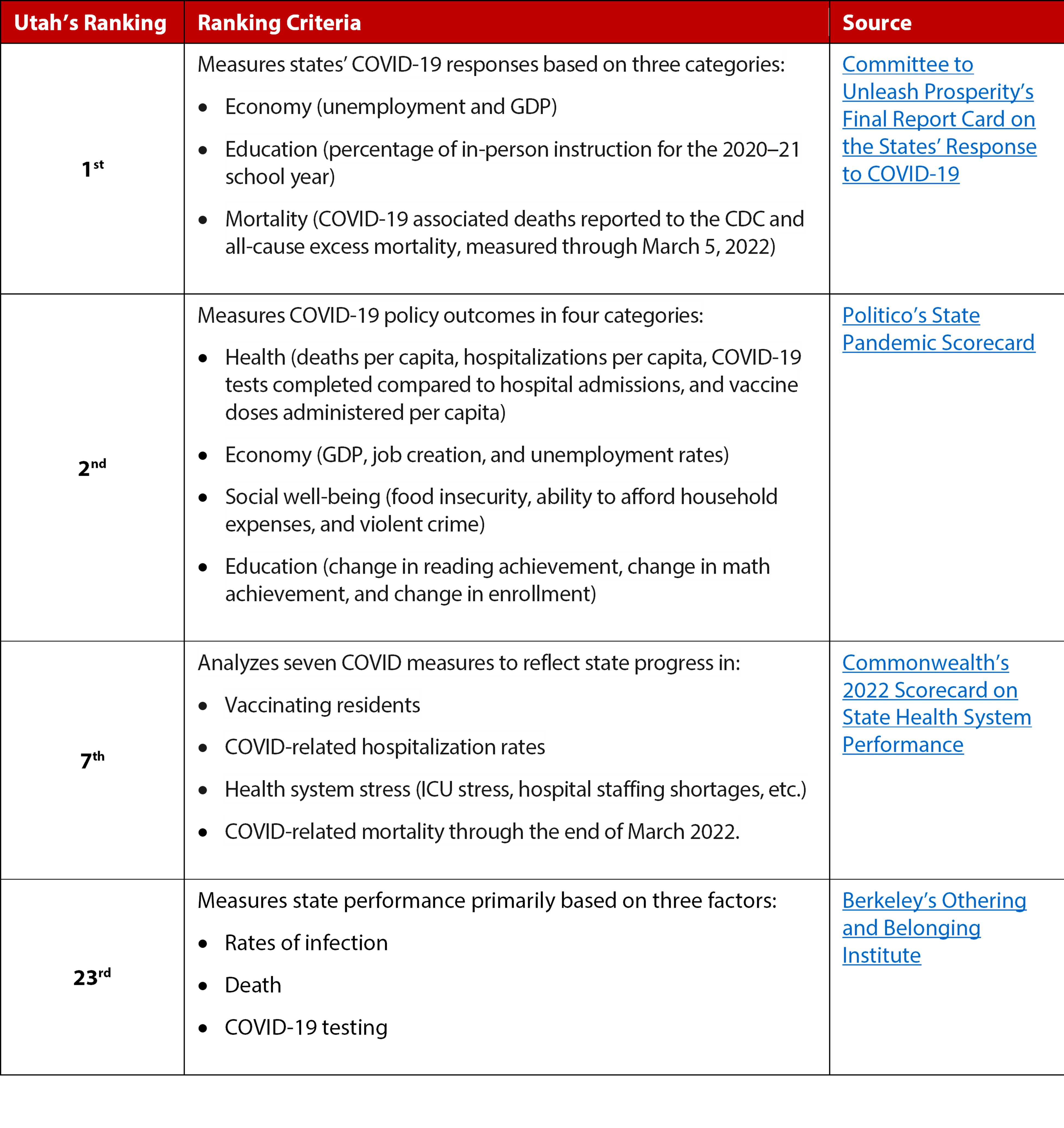Blog Post
Insight: COVID-19 Rankings: Where Does Utah Fall?
By: Laura Summers
Jul 28, 2022 – Given that COVID-19 is now (somewhat) in our rear-view mirror, it is interesting to look-back to see how well our state performed. Unfortunately, this pandemic impacted more than just a person’s health, and there are a myriad of economic, social, and education-related measures one could examine when evaluating a state’s performance.
To get a glimpse at understanding how well Utah performed, I’ve compiled its ranking on four composite measures into the table below. While not comprehensive, the rankings represent available analyses that present a composite score as opposed to a single narrow measure. They also come from a mix of academic, nonprofit, and other entities and are developed using different data from different periods of time. As such, they are not directly comparable, but when combined, present the beginning of a picture of how well Utah responded to the pandemic.
Looking at the rankings in Table 1, Utah performed extremely well relative to other states when it comes to its COVID-19 response. Utah ranks first and second on two of the rankings and in the top 10 on three of the four. The fourth measure, from Berkeley’s Othering and Belonging Institute, only takes into account health-related measures such as rates of infection, death and testing, rather than a more comprehensive view of the economy and social factors.
Table 1: Utah’s Ranking on Four Composite Measures of States’ COVID-19 Response
Certainly, the list of rankings included above is not inclusive of every ranking and measure. Data from the Centers for Disease Control and Prevention (CDC), for example, show that the share of Utah’s population who have been fully vaccinated falls below the national average.[i] Utah is also close to or above the national average when it comes to the percent of adults reporting symptoms of anxiety or depressive disorder during the COVID-19 pandemic.[ii] That said, Utah has the lowest share of adults with higher risk of serious illness if infected with COVID-19 in the country, based on analysis of Behavioral Risk Factor Surveillance System (BRFSS) data by Kaiser Family Foundation.[iii]
What these rankings do tell us, however, is that Utah faired quite well when it came to COVID-19, particularly when considering its response in the context of multiple domains. While I don’t think anyone would question that there are significant lessons learned from this pandemic—and there is always room for improvement—our state can hopefully take these lessons, couple them with what it did right, and be prepared to execute efficiently and effectively during the next economic or public health emergency.
Laura Summers is the senior health care analyst at the Kem C. Gardner Policy Institute.
Note: The opinions expressed are those of the author alone and do not reflect an institutional position of the Gardner Institute. We hope the opinions shared contribute to the marketplace of ideas and help people as they formulate their own INFORMED DECISIONS™.
[i] https://www.kff.org/other/state-indicator/covid-19-vaccines-delivered-and-administered/
[ii] Data is from March 2, 2022 – March 14, 2022. Available from https://www.kff.org/other/state-indicator/adults-reporting-symptoms-of-anxiety-or-depressive-disorder-during-covid-19-pandemic/
[iii] https://www.kff.org/other/state-indicator/adults-at-higher-risk-of-serious-illness-if-infected-with-coronavirus/







